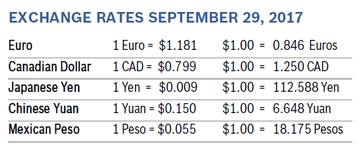|
Market Watch September 29, 2017 All three indexes posted gains for both the month of September and the third quarter, with the DOW recording eight consecutive positive quarters, the longest winning streak since 1997. The NASDAQ has also posted eight winning quarters. The DOW rose 2.1% in September and was up 4.9% for the quarter, the tech-heavy NASDAQ rose 1.0% for the month and 5.8% for the quarter and the S&P, the index most closely followed by economists, gained 1.9% for the month and was up 3.9% for the quarter. It was also the least volatile September for the markets in many years. Consumer Confidence Falls Slightly The New York-based Conference Board's Consumer Confidence Index fell 0.6 points in September to 119.8 from a downwardly revised reading of 120.4 in August. The Present Situation Index dropped to 146.1 from a downwardly revised 148.4. The Expectations Index rose slightly to 102.2 from a downwardly revised 101.7 in August. The Expectations Index is typically the most volatile of all the components. The Conference Board said that the overall index was affected by big drops in confidence in Texas and Florida, the two states most severely impacted by Hurricanes Harvey and Irma. Economists say a level of 90 indicates that the economy is on solid footing and a level of 100 or more indicates growth. Analysts caution that the real driver behind consumer spending is income growth and that labor market trends are a more accurate predictor of consumer behavior. Consumer spending rises 0.1% Consumer spending inched up 0.1% in August after rising 0.3% in July. The core personal consumption expenditures index (PCE) rose 0.1% in August and 1.3% year over year after rising 1.4% in July. Incomes grew 0.2% in August after increasing a downwardly revised 0.3% in July. Consumer spending in August was depressed by a 1.1% drop in spending on durable goods, led by a big decline in spending on new motor vehicles. Auto manufacturers reported that Hurricane Harvey impacted sales during the last week in August. Consumer spending is closely watched by economists because it accounts for 70% of U.S. economic activity. Consumer Prices rise 0.4% The Consumer Price Index (CPI) rose 0.4% in August after rising 0.1% in July. The CPI was up 1.9% from August 2016. Core inflation, which excludes food and energy, rose 0.2% and was up 1.7% year over year. Core inflation has consistently been below the Fed’s target of 2%. Most of the rise in prices came from increases in the cost of housing and gasoline. Analysts believe that the Fed will hold off increasing interest rates for now, and will want to see what impact Hurricanes Harvey and Irma have on the overall economy before considering raising rates. Unemployment Falls to 4.2% The unemployment rate fell to 4.2% in September after rising to 4.4% in August. Two destructive hurricanes had an impact on job growth, with the economy losing 33,000 jobs, the first decline since September 2010. Analysts had been expecting job growth to slump, but still expected the economy to add about 75,000 jobs. Foodservice and drinking establishments lost more than 100,000 jobs in September, most likely as a result of storm-caused closings. The number of Americans filing for unemployment benefits hit a two-year high in the first week of September. The average number of hours worked remained about the same and earnings rose 0.3%. Earnings are up 2.6% from September 2016. Consulting firm RSM reports that in storm-hit areas construction companies are struggling to find skilled and qualified workers. The economy needs to create just under 100,000 jobs each month to keep up with growth in the working-age population, according to Fed Chair Janet Yellen. Durable Goods Orders Rise 1.7% Durable goods orders rose 1.7% in August after falling 6.8% in July. The unexpected increase was primarily due to a 45% surge in orders for commercial aircraft. Excluding the volatile transportation category durable goods orders increased by 0.2% in August after rising 0.5% in July. Orders for non-defense capital goods excluding aircraft, a closely watched indicator of business spending, rose by 0.9% in August after rising 0.4% in July. Shipments in the same category, which factor into GDP, rose 0.7% in August after rising 1.1% in July. Orders for machinery, primary metals, computers, electronic products and transportation equipment all increased. The durable goods report is often both volatile and subject to sharp revisions. Chicago PMI Rises to 65.2 The Chicago Purchasing Managers’ Index (PMI) rose to 65.2 in September from 58.9 in August, reaching the highest level in three months. All of the index’s components rose in September, boosting the three-month average for the index to 61.1, virtually unchanged from the 3-month average for the second quarter. Elevated commodities prices and hurricane-induced shortages pushed Prices Paid to a level last seen in July 2011. Some firms stockpiled goods, leading to an 8.4 point jump in inventory levels. Firms expect a busy fourth quarter and surprisingly few anticipate major delivery delays due to hurricane-caused disruptions in the supply chain. Wholesale Prices rise 0.2% The Producer Price Index (PPI) rose 0.2% in August after falling 0.1% in July and was up 2.4% over the past twelve months. Core inflation, which excludes volatile food, energy and trade services prices, rose 0.1% in August after falling 0.1% in July and was up 2.0% from August 2016. The PPI for inputs to construction was up 0.3% in August and 3.2% year over year. For the past five years of the recovery inflation has been below the Federal Reserve’s target for annual price gains of around 2%. The PPI survey data was gathered before Hurricanes Harvey and Irma inflicted billions of dollars in losses, which will most likely cause further, and possibly sharper, increases in prices in the coming months as demand for materials needed to rebuild and restore infrastructure climbs. Q2 GDP Rises 3.1% GDP grew an upwardly revised 3.1% in the second quarter, up from the 2.6% growth initially reported and the previous upward revision to 3.0% growth. It was the best growth in two years. Stronger business spending led to the upward revision. Nonresidential fixed investment, a measure of business spending on equipment, software and commercial space, grew 6.7%, slightly lower than previously reported but still solid. Many private-sector economists estimate economic output fell to between 1% and 2% in the third quarter, but expect growth to rebound in the fourth quarter and early next year as hurricane-impacted communities rebuild, consumers and businesses step up spending and the global economy gains traction. Consumer spending was unrevised at 3.3% for the quarter, up from the initial reading of 2.8% and a big improvement from 1.9% in the first quarter. Job openings little changed The number of job openings was little changed at 6.2 million in July, according to the latest Jobs Openings and Labor Turnover Survey (JOLTS). Hires and separations were also little changed, at 5.5 million and 5.3 million, respectively. Within separations, the quits rate was little changed at 2.2% and the layoffs and discharges rate also held steady at 1.2%. The job openings rate remained at 4%. The ratio of available workers per available job remained low, with managers now having about 1.1 candidates per job opening, making competition fierce for talent. Economists warn that the record level of job openings could negatively impact economic growth. The JOLTS report is one of Fed Chair Janet Yellen’s preferred economic indicators. Government Shutdown Avoided President Donald Trump ignored his own party's leaders and sided with Democrats on a deal to bundle Hurricane Harvey relief funds, a three-month increase on the debt limit and a three-month continuing resolution to keep the government funded. Republicans would have preferred a longer extension to avoid another fight when the three months run out December 15. Both sides agreed they would work diligently to pass something longer term and avoid a holiday government shut down. S&P warned that failing to raise the debt limit would have been more catastrophic to the economy than the 2008 failure of Lehman Brothers and would have erased many of the gains of the recovery. They noted that in the event of a default the plunge in government spending would put the economy back into a recession. Economic Growth Projections The economy will grow 2.2% this year and 2.4% in 2018, according to the latest survey of nearly four dozen economists by the National Association for Business Economics (NABE). The odds of recession this year and next year remain very low. The Trump administration has forecast that GDP will increase gradually to 3% by 2020. © Robert Bosch Tool Corporation. All rights reserved, no copying or reproducing is permitted without prior written approval.
Comments are closed.
|
|








